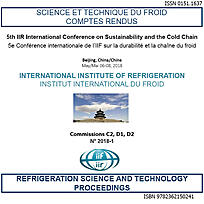
Summary
With the development of the national economy and the continuous improvement of people’s requirements for food, the cold-chain logistics will enjoy more and more attention. The yields of fruits and vegetables in our country has been huge in recent years. To meet the trend of energy conservation and emission reduction and quantify the effect of cold chain on the environment, the life cycle assessment method was used to analyze the carbon footprint of fruits and vegetables cold-chain in the life cycle. The results show that the in each phase of cold chain, the carbon footprint of transportation accounts for a large proportion. As the storage time increases, the carbon footprint of the cold chain increases.The carbon footprint of the refrigerated transport phase and pre-refrigerated storage phase accounts for 50% -70% of the total cold chain. When the transport distance is short, the storage stage is dominant, and as the transport distance increases, the carbon footprint generated also increases.
Available documents
Format PDF
Pages: 9
Available
Public price
20 €
Member price*
Free
* Best rate depending on membership category (see the detailed benefits of individual and corporate memberships).
Details
- Original title: Analysis of cold chain carbon footprint of fruits and vegetables in China
- Record ID : 30023339
- Languages: English
- Source: 5th IIR International Conference on Sustainability and the Cold Chain. Proceedings: Beijing, Chine, 6-8 avril 2018
- Publication date: 2018/04/06
- DOI: http://dx.doi.org/10.18462/iir.iccc.2018.0001
Links
See other articles from the proceedings (72)
See the conference proceedings
-
Development of cold chain in Russia.
- Author(s) : BELOZEROV G., TVOROGOVA A., ANDREEV S., et al.
- Date : 2011/08/21
- Languages : English
- Source: Proceedings of the 23rd IIR International Congress of Refrigeration: Prague, Czech Republic, August 21-26, 2011. Overarching theme: Refrigeration for Sustainable Development.
- Formats : PDF
View record
-
Huella de carbono del transporte refrigerado.
- Author(s) : RASINES L., SAN MIGUEL G., ARTÉS-HERNÁNDEZ F., AGUAYO E.
- Date : 2022/04
- Languages : Spanish
- Source: XI Congreso Ibérico y IX Congreso Iberoamericano de Ciencias y Técnicas del Frío, CYTEF 2022.
- Formats : PDF
View record
-
Cold storage in India for small farmers - curre...
- Author(s) : TIWARI A., HARISCHANDER H., RANE M.
- Date : 2022
- Languages : English
- Source: 2022 Purdue Conferences. 19th International Refrigeration and Air-Conditioning Conference at Purdue.
- Formats : PDF
View record
-
Flexibilidade, eficiência e segurança na logíst...
- Author(s) : PAES MOREIRA M., GOMES LAURIANO de SOUZA V., FERNANDO A. L., et al.
- Date : 2016/05/03
- Languages : Portuguese
- Source: CYTEF 2016. VIII Congreso Ibérico y VI Congreso Iberoamericano de las Ciencias y Técnicas del Frío, Coimbra-Portugal, 3-6 mayo, 2016.
- Formats : PDF
View record
-
UK cold stores – the road to net zero.
- Author(s) : COTTER D., MARQUES C., DAVIES G., LAGOEIRO H., FOSTER A., EVANS J.
- Date : 2024/06/11
- Languages : English
- Source: 8th IIR International Conference on Sustainability and the Cold Chain. Proceedings: June 9-11 2024
- Formats : PDF
View record
